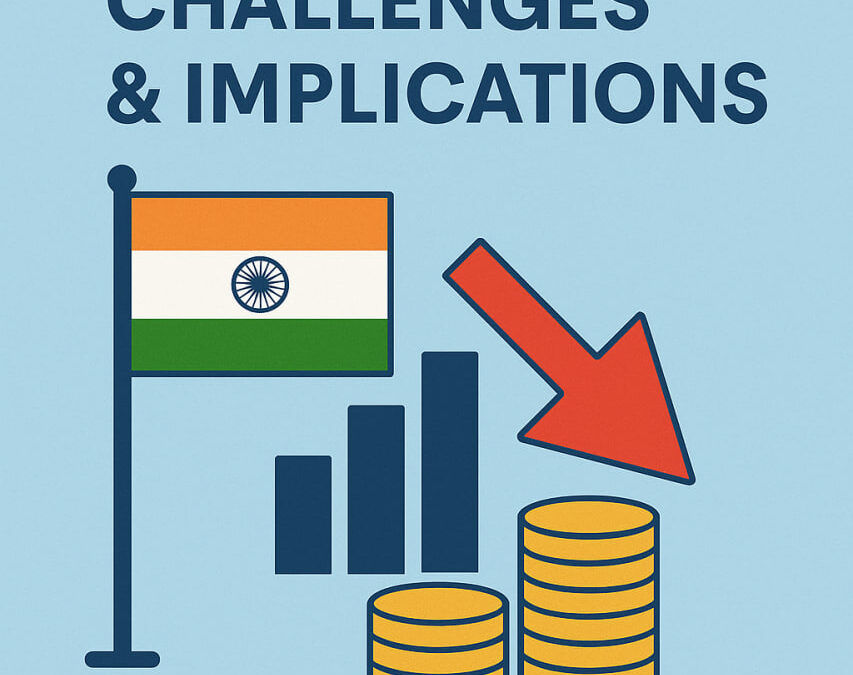India’s Trade Deficit: Challenges & Implications

Bridging Global Workforce Gaps
June 20, 2025
Agriculture Extension System in India: Strengthening Rural Empowerment
June 23, 2025India’s Trade Deficit: Challenges & Implications
Why in News?
According to official data from the Union Ministry of Commerce and Industry, India recorded a trade deficit with 9 out of its top 10 trading partners in FY 2023-24.
Current Status of India’s External Trade (FY 2023-24)
What is a Trade Deficit?
- A trade deficit (negative trade balance) occurs when a country’s imports exceed its exports.
- It indicates higher dependency on foreign goods and services.
India’s Major Trading Partners (FY 2023-24)
- Largest Trading Partners (Descending Order):
China > USA > UAE > Russia > Saudi Arabia. - Countries with Increased Trade Deficit:
- China, Russia, South Korea, Hong Kong (deficit widened).
- Countries with Narrowed Trade Deficit:
- UAE, Saudi Arabia, Indonesia, Iraq.
- Countries with Trade Surplus:
- USA, Netherlands, UK, Belgium, Italy.
Impact of a High Trade Deficit on the Economy
Negative Impacts
- Depletion of Forex Reserves
- Excess imports require foreign currency payments, leading to higher demand for dollars.
- This can weaken the rupee and increase import costs.
- Widening Current Account Deficit (CAD)
- A high trade deficit increases the Current Account Deficit (CAD).
- A higher CAD may affect India’s credit rating, making foreign borrowing costlier.
- Strategic Concerns
- Dependence on essential imports (e.g., crude oil, electronics, pharmaceuticals) may impact economic security.
Positive Impacts
- Diverse Consumer Choices
- Access to a wider variety of goods enhances consumer welfare.
- Boost in Capital Investments
- A trade deficit driven by capital goods imports can support industrial growth and modernization.
Reasons Behind India’s High Trade Deficit
1. Heavy Dependence on Imports
- India imports a significant portion of essential goods, including:
- Crude oil (energy needs).
- Electronic components (mobile phones, semiconductors).
- Pharmaceutical ingredients (Active Pharmaceutical Ingredients – APIs).
2. Changing Consumer Demand
- Rising income levels have led to higher demand for imported luxury goods and consumer durables.
3. Structural Issues
- Slow Manufacturing Growth: India’s manufacturing sector growth remains sub-optimal.
- Logistics Costs: Higher transport and warehousing costs make Indian exports less competitive.
- Infrastructure Bottlenecks: Poor port connectivity, road infrastructure, and energy supply hinder production.
4. Domestic Policy Challenges
- Inverted Duty Structure: Higher import duties on raw materials compared to finished goods discourage domestic manufacturing.
- Export Restrictions: Frequent bans on agricultural exports reduce India’s competitiveness in global trade.
5. External Trade Barriers
- Limited FTA Utilization: India has Free Trade Agreements (FTAs) with multiple countries but does not fully utilize their potential.
- Non-Tariff Barriers (NTBs): Developed nations impose stringent quality, safety, and environmental standards, restricting Indian exports.
Way Forward: Reducing Trade Deficit
1. Boost Domestic Manufacturing
- Encourage “Make in India” initiatives to promote local production of electronics, pharmaceuticals, and automobiles.
- Expand the Production Linked Incentive (PLI) Scheme to enhance global competitiveness.
2. Strengthen Export Promotion Strategies
- Improve Export Infrastructure: Modernize ports, roads, and storage facilities to reduce costs.
- Leverage FTAs: Ensure better utilization of existing trade agreements.
3. Diversify Energy Imports
- Reduce dependence on crude oil by expanding renewable energy sources such as solar, wind, and biofuels.
4. Address Policy Bottlenecks
- Rationalize Import Duties: Fix the inverted duty structure to promote domestic value addition.
- Avoid Frequent Export Restrictions: Ensure stable agricultural and industrial export policies.
5. Enhance Trade Relations
- Strengthen trade ties with USA, EU, ASEAN, and Africa to expand India’s export market.
Multiple Choice Questions (MCQs)
1. Which of the following correctly defines a “trade deficit”?
(a) When a country exports more than it imports.
(b) When a country imports more than it exports.
(c) When a country’s imports and exports are equal.
(d) When a country has a surplus foreign exchange reserve.
Answer: (b) When a country imports more than it exports.
2. Which of the following is a major reason behind India’s trade deficit?
(a) Low crude oil prices globally.
(b) Higher export volumes compared to imports.
(c) Dependence on imported raw materials like crude oil and electronics.
(d) Consistent trade surplus with major economies like China and the USA.
Answer: (c) Dependence on imported raw materials like crude oil and electronics.
UPSC Mains Questions
1. India’s persistent trade deficit has multiple economic and strategic implications. Analyze the causes and suggest measures to address the issue.
2. Discuss the impact of trade deficit on India’s economic stability. How can India reduce its trade deficit while maintaining sustainable economic growth?
Post Views: 9

